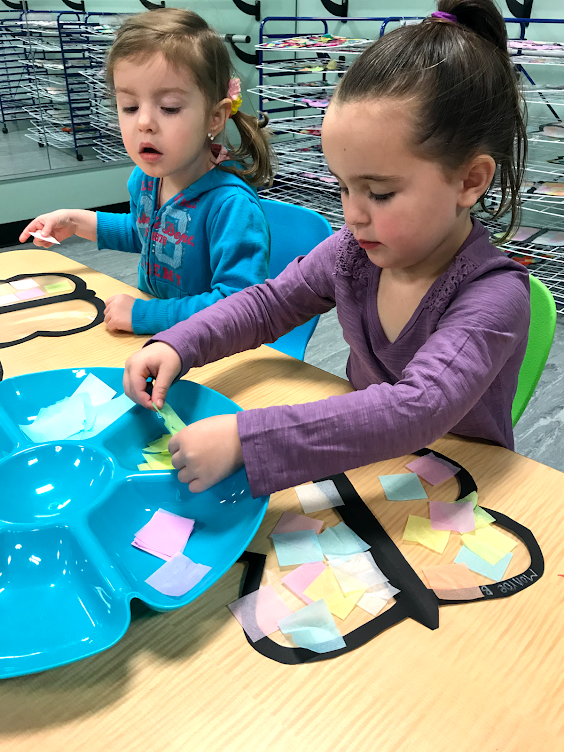At UDA Creative Arts Preschool in Utah, we have loads of fun every day. It’s meant to be that way! But our activities are also carefully curated to help children learn and develop in several areas: Reading/Writing, Math, Science, Art, Creative Movement and Dance, Social Studies, Character Development, and Music.
Because children learn through play, all these areas of focus are presented in playful, imaginative ways so that children can grasp concepts more thoroughly and at their own pace.
You can do this in your family too, both at home and on the go! Read on for 23 ideas for family activities for preschoolers in math, reading, science, and creative movement.
Math Family Activities for Preschoolers
Math is everywhere, and simply pointing that out can be a huge boost to your child’s understanding of numbers. You can incorporate math activities into your everyday life. For example, ask your child to count how many stop signs you see on the way to preschool. Or at snack time, count out 10 goldfish crackers together, and ask your child to tell you how many will be left when they eat one. Or count the steps to your front door.
And then try these fun math family activities for preschoolers:
- Have a Numbers Picnic: Plan a picnic where your food items go in numerical order. For example, maybe there’s one orange, two sandwiches, three cookies, four bunches of grapes, etc. Have your child help you prepare the picnic, and then have them line the items up in numerical order. As you decide what to eat first, you can go in numerical order, backwards, evens first, odds first, etc.
- Cook or Bake Together: Let your child read the numbers of the measurements if they’re able. Have them measure the ingredients (or help you).
- Make Playdoh Together: Not only is playdoh fun to make and play with, the process of making it can boost your child’s math understanding. Plus, it’s a great multi-sensory activity — this is a recipe your child can really stick their hands into.{Try this easy playdoh recipe together}
- Work on a Puzzle Together: One study found that puzzle play between the ages of 2 and 4 helped children develop better spatial skills, an important concept in math.
- Play Card Games: The old standbys, like Go Fish, War, and Uno, have simple-enough rules that young children can grasp the concepts.
- Play Bingo: Everyone loves the chance to call out Bingo, and playing Bingo can help your child improve number (and some letter) recognition.
- Make Fruit Kebabs: For a tasty math activity, work on patterns by making fruit kebabs
Science Family Activities
Look around you — you’re holding technology in your hands, there’s nature just outside the window, and electricity is pumping through your home. Being an observer is one of the most important skills of science, and just like math, science is everywhere. Help your child become an observer too, and try these fun science family activities.
- Look at the Stars: Stay up late and look at the stars and moon. Observe what you see, and share what you remember from elementary school science. (Read a little beforehand if you don’t remember much!) Stargazing almost always leads to big questions, so be prepared to look up the answers.
- Make Tie-Dye: Freshen up your family wardrobe with some new tie-dye. Talk about the chemical reaction that’s taking place between the dye and the fabric molecules.
- Go for a Nature Walk: A good scientist observes. Take binoculars, magnifying glass, and notepad to observe and study what you see in nature. Responsibly take back leaves or pebbles to use in artwork.
- Grow a Garden: Plant seeds, and tend a garden together. Make predictions for what will happen. Observe the plant’s growth.
Movement Activities
Creating a family culture of movement and play will help your child develop healthy exercise habits. Plus, movement is important for young children, who need to develop strength and mobility. Try these fun family activities for preschoolers.
- 4-square: Bring back an old playground favorite that involves eye-hand coordination, quick feet, and strength.
- Make an Obstacle Course: Kids love obstacle courses, and they’re a great way to encourage different types of movement.
- Play Charades: Laugh together as you try to use your body to act things out. If your child isn’t reading yet, draw your clues instead of writing them.
- Play Balloon Games: Balloons are great tools for teaching hand-eye coordination, because they move so slowly and give your child enough time to get where they need to be. Play catch, keep the balloon off the floor, balloon volleyball, and more.
- Freeze Dance: Freeze dance is one of those perfect ideas to keep in your back pocket. Not only does it inspire movement, it can quickly turn a sour mood happy. Use this game liberally.
Family Activities for Preschoolers to Help with Reading
Read! Read as much as you can! And then have fun with these reading and pre-reading activities.
- Have a Letter Picnic: Can you pack something that starts with every letter of the alphabet? If that’s too much, how about every letter of your child’s name?
- Put on a Play: If your child can read, write a script together. If they can’t yet, draw images to remind them of each scene. Or let your child put on a play free-style — storytelling in and of itself is an important pre-reading skill.
- Go on a Treasure Hunt: Send your child on a treasure hunt, in which they have to follow written clues (if they can read) or certain letters.

- Spot Your Letter: Even young preschoolers can learn to recognize the first letter of their name. Make this their special letter, and search for it everywhere you go: on traffic signs, on stores, etc.
- Play Pass the Story: Start a story, and pause dramatically at a critical point. Ask your child to finish it. You can do this with familiar stories, like The Three Little Pigs, or you can make up stories as you go.
- Tell Family Stories: Pull out photo albums and tell the stories of your family. Storytelling is an important reading skill, and hearing about family members keeps children engaged and grounded.
- Keep a Travel Log: Get a special notebook for your summer activities, your vacations, or your weekend adventures. Have everyone take a turn writing or drawing a picture about your experiences.
Learn how we incorporate all of these subjects and more at UDA Creative Arts Preschool. We invite you to come watch us in action. You can schedule a tour today by calling (801) 523-5930.
























